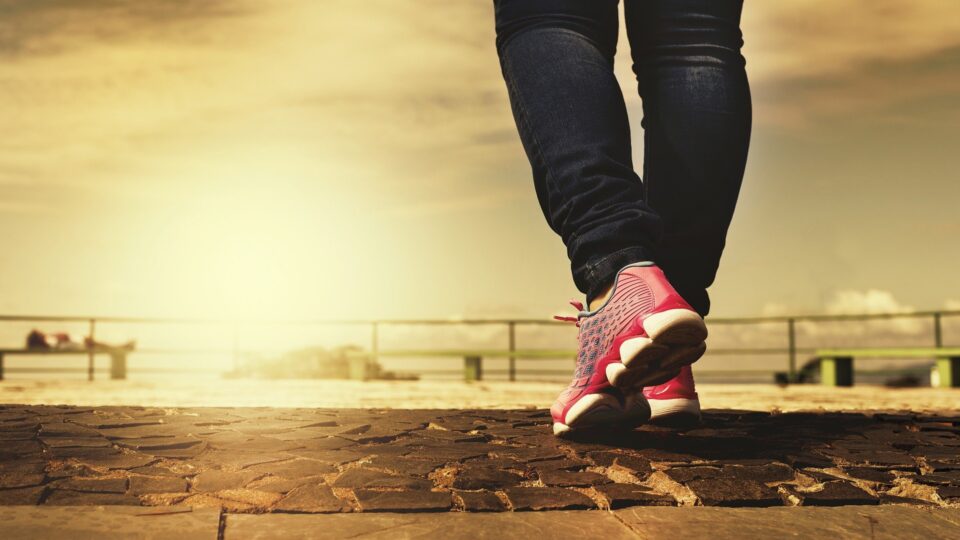The Key Fat Loss Ingredient You’re Not Doing Enough Of
In every one of our fat loss programs, we advocate movement (and lots of it). Not in a traditional exercise sense (hitting the gym, going on a run, etc.), but in the context of daily living. Are you sitting more than you’re standing? Are you on the move more than you’re on the couch? How much are you gardening, doing laundry, having sex, taking the stairs, fidgeting, or going on a leisurely walk?
This isn’t exactly a novel idea. Most of us know that standing is better than sitting, and walking is better than television when it comes to our health. We get it on a visceral level: our low back hurts, our brains are foggy, and our hip flexors are way too tight.
Yet, we ignore the movement piece and focus all of our attention on traditional exercise.
The problem is that when we look at total daily energy expenditure (TDEE), or how many calories we burn each day, we can’t change that to a large degree. Our basal metabolic rate (BMR) makes up most of TDEE and is very difficult to change. Considering what we can change – the foods we eat, the workouts we engage in, and our daily movement – the movement portion is by far the most crucial piece of the pie.
Everybody focuses their attention on the exercise piece (or exercise activity thermogenesis for the nerds in the group), but it’s a losing proposition. Not only does it make up a tiny portion of changeable metabolism (~5%), but to continue to lose weight, you’ll have to continue doing the same amount of exercise, plus some, to keep that weight off. In contrast, movement (NEAT or Non-Exercise Associated Thermogenesis for the nerds) is responsible for three times that.
Taking daily walks is the best way to increase NEAT and is something we encourage our clients, employees, and family members to do at Metabolic Living.
Our ancestors walked between 12 and 20 miles per day. In today’s world, we’re lucky to get 10,000 steps in a day.
But walking has a marketing problem. It’s not as sexy as the latest gizmos and gadgets or the latest weight loss drug. It doesn’t make for a great YouTube video or quick-fix solution.
Many see it as a waste of time, an additional item on their to-do list, or ineffective (How would losing 50 pounds by walking twice a day for 18 months look on a billboard? Hint: not well).
So, here’s my best attempt at a marketing campaign for walking.
What if I told you that body change is more than calories-in verse calories-out? That is a pivotal piece to the puzzle that millions of people are ignoring. This missing element will help change your body’s shape and improve your mood, lower your stress, increase creativity, and help you focus at work.
What I’m talking about is leisurely walking. Yes, daily walks around your local neighborhood, park, or trail.
Leisurely walking has been shown to reduce the stress hormone cortisol. Cortisol is released when the body is under stress (physical or mental) and was useful to our ancestors to escape an attack by a saber tooth tiger. Stress hormones like cortisol are released into the bloodstream so we can fight or flight-the-heck-out-of-there. Once we escaped the sharp-toothed feline, we’d calm down, and stress hormones would return to normal.
Nowadays, saber-tooth tigers aren’t threatening to eat our face while we’re enjoying Eggs Benedict. Instead, stress from work, bad dates, and endless to-do lists keep our cortisol levels high moment after moment, day after day.
When cortisol levels stay too high for too long, it causes us to lose muscle, store fat, and develop serious pizza cravings.
Taking a nice relaxing walk is just what we need to bring our stress hormones back to normal.
And if you act now, there’s a bonus. To get these benefits, you don’t have to put on a headband and prepare for an elevated heart rate and a sweaty hairdo. There’s no need to power walk. Instead, add a nice and slow leisurely walk (about a speed of 2.0 on a treadmill).
But wait, there’s more!
Research shows that being in nature, or merely looking at nature on your screen saver for five minutes, lowers cortisol levels and blood pressure.
In her book The Willpower Instinct, Kelly McGonigal says, “Just five minutes of what scientists call “green exercise” (what the Japanese call “Shinrin-yoku,” meaning “forest bathing”) decreases stress, improves mood, enhances focus, and boosts self-control.”
So even if you’re crunched for time, a 5-minute walk around the block can do wonders.
And as with all profitable marketing campaigns, here’s your call to action:
Walk daily, especially in or through nature, and get the entire package:
- Improve your mood
- Decrease your stress, hunger, and cravings
- Increase energy
- Improve your sleep
- Become more productive
- Burn fat
Make walking a necessity. As Dr. Jade Teta says, “We don’t view walking as exercise, but rather a necessity.”
When we view it as a necessity, like brushing our teeth or taking a shower, we can begin to make time for it.
Try it today, and tomorrow, and actually, try it every day! I guarantee its power or your money back!
How did I do? Are you sold? Are you lacing up your walking shoes as we speak? No? Well, I tried. I’m going on a walk to clear my head.
_________________________________________________________________________________
Sources:
- Teta, Jade. “Two Changes to Your Walking Will Lower Cortisol Even More.” Metabolic Effect. N.p., 22 Apr. 2009. Web.
- Teta, Jade. “Walking & Intense Training: Synergistic for Fat Loss.” Metabolic Effect. N.p., 21 May 2010. Web.
- McGonigal, Kelly. The Willpower Instinct: How Self-Control Works, Why It Matters, and What You Can Do to Get More of It. New York: Avery, 2012. Print.

